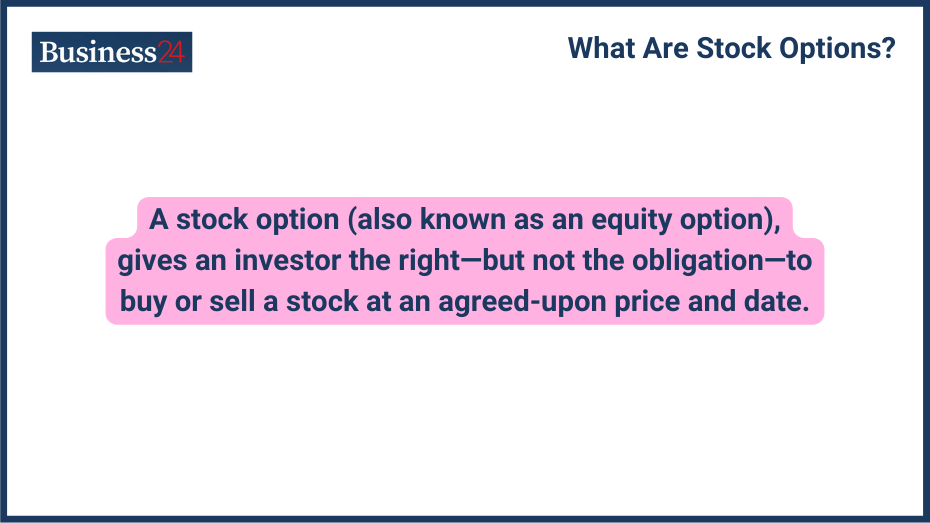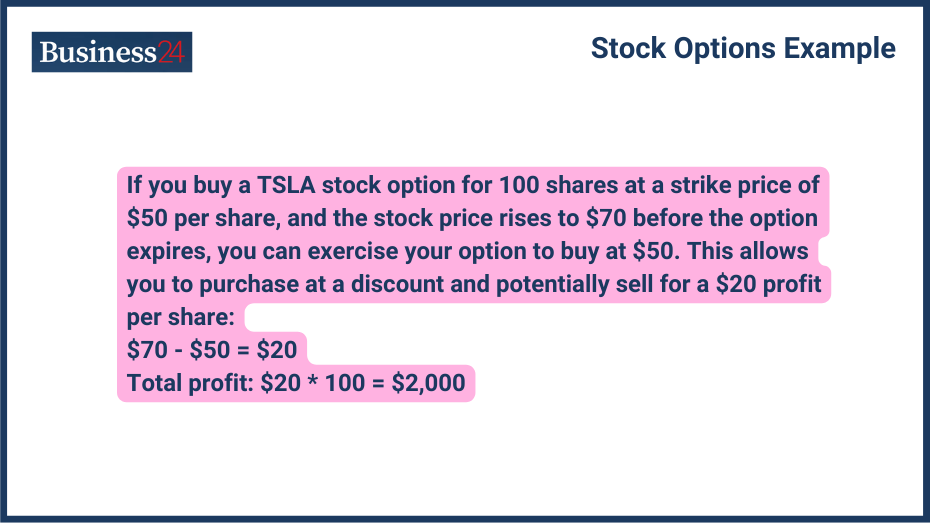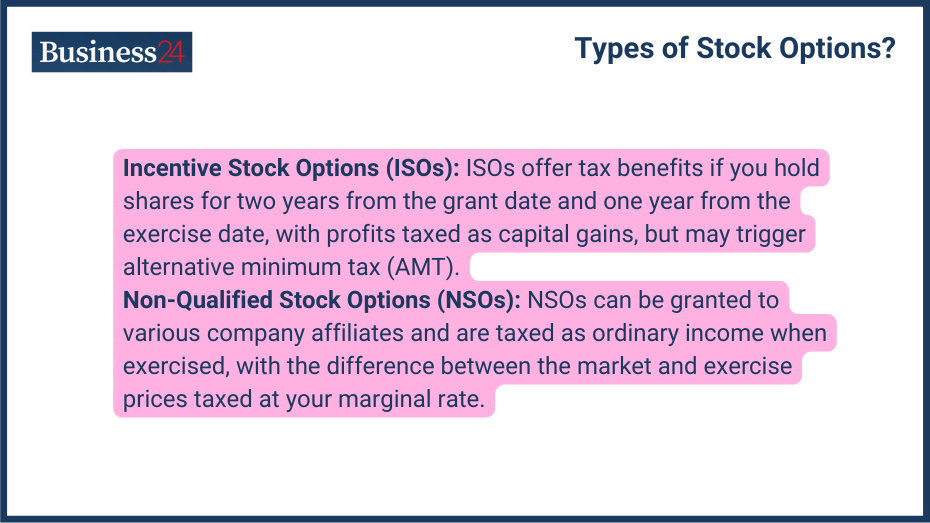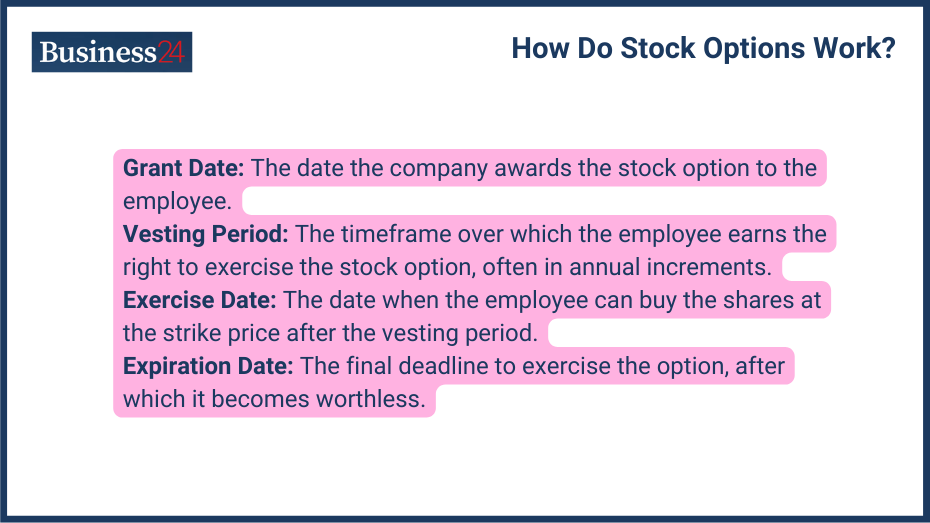
A stock option (also known as an equity option), gives an investor the right—but not the obligation—to buy or sell a stock at an agreed-upon price and date.
Options are nowadays the favorite instrument of traders; there are many option contracts in different assets. There are option contracts for indexes, commodities, currency, etc., and like that, there are option contracts for stocks too. Stock options are derived from the underlying stock and replicate the movement of the stock based on different variables like delta, gamma, theta, etc.
As you might know by the definition of an option contract, a stock option is a contract that grants the holder the right, but not the obligation, to buy or sell a specific number of shares of a particular stock option contract at a strike price by the time of expiry.
Stock Option Example

Let’s say, for example, you buy a stock option of TSLA of 100 shares at a price of $50 per share (strike price) within two years (expiration date). Now, If the TSLA’s stock price rises to $70 per share before the expiration date, you can exercise your option to buy at $50. This lets you purchase the shares at a discount and potentially sell them right away for a $20 profit per share:
$70 – $50 = $20
Total profit – $20*100 = $2,000
But, If the stock price stays around $50 or falls below $50, exercising the option wouldn’t be profitable because the time value of the option decreases as it approaches the expiration date. You’d be better off letting the option expire worthless and keeping your money.
What are the Types of Stock Options?

There are two main categories of stock options: incentive stock options (ISOs) and non-qualified stock options (NSOs).
- Incentive Stock Options (ISOs): Whenever you join a company that gives its employees stock options as compensation, you are entitled to incentive stock options. The key benefit of ISOs is that they are good fot tax purposes. If you hold the acquired shares for at least two years after the option grant date and one year after the exercise date, any profit generated when you eventually sell the shares is typically taxed as capital gains (potentially at a lower rate than ordinary income tax). However, exercising ISOs can trigger an alternative minimum tax (AMT) liability in some cases.
- Non-Qualified Stock Options (NSOs): NSOs are a broader category of stock options that can be granted to employees, directors, contractors, consultants, or advisors of a company. They are more common than ISOs and offer a simpler structure. NSOs are treated differently from a tax perspective. When you exercise an NSO and purchase shares, the difference between the market price of the stock at that time and the exercise price is typically considered ordinary income and taxed accordingly. This means you’ll pay taxes on this amount at your marginal income tax rate in the year you exercise the option.
How Do Stock Options Work?

Nowadays, stock compensation for employees is in trend; according to companies, these shareholdings make an employee work harder, so the stock price can rise, and so does the value of the stock option.
Companies give stock options to employees as a long-term incentive. This helps align what employees want with what shareholders want. By allowing employees to buy shares at a set price, companies hope to encourage them to stay with the company and help it grow.
To understand how these stock options work, you have to know about the key dates involved and how these stock options evolve with time:
- Grant Date: This is the date the company officially awards the stock option to the employee.
- Vesting Period: The vesting period defines the timeframe over which the employee earns the right to exercise the stock option. For example, the options might vest 25% each year over a four-year period. Until an option vests, the employee doesn’t have the right to purchase the shares.
- Exercise Date: This is the date after the vesting period when the employee becomes eligible to buy the shares at the strike price.
- Expiration Date: This is the final deadline by which the employee must exercise the option. If not exercised by the expiration date, the option becomes worthless.
What are the Benefits of Stock Options?
Stock options offer several advantages for both companies and employees. If planned and used efficiently it will help to grow the company.
- Incentive for Employees: When an employee is given a stock option, he becomes invested in the company and will benefit if the stock price goes up. The company’s stock price goes up when the company grows its business. This will motivate employees to perform better and contribute to the company’s growth. It creates a sense of ownership and a results-oriented culture within the organization.
- Potential for Financial Gain: Stock options offer employees the opportunity to benefit directly from the company’s success. For example, recently, NVDIA’s stock price rocketed, and employees who held the company’s stocks benefited greatly from the price rise. This potential for financial gain can be a significant motivator for employees, attracting and retaining top talent.
- Tax Advantages (ISOs): Incentive stock options (ISOs) have the potential for favorable tax treatment. If the holding period requirements are met, any profit generated upon selling the acquired shares is typically taxed as capital gains, which can be a lower tax rate than ordinary income tax. This tax benefit adds to the overall attractiveness of ISOs for employees.
- Attracting and Retaining Talent: Companies can use stock options as a competitive tool to attract and retain high-performing employees. By offering the potential for significant financial rewards tied to the company’s success, stock options can be a valuable addition to compensation packages, making the company a more attractive employer in the job market.
How do you get paid in stock options?
Stock options aren’t a direct form of payment. They are just a medium for companies to pay their employees. The company grants you stock options as part of your compensation package. This specifies the number of shares you can buy, the strike price, the vesting period, and the expiration date.
Once an option vests, you can choose to exercise it by paying the strike price to purchase the underlying shares. This requires an upfront cash outlay. After buying the shares through exercising options, you can hold them for long-term investment or sell them on the stock market to generate a profit.
The profit or loss you realize depends on the difference between the market price when you sell the shares and the strike price you pay to buy them.
What are the Risks of Stock Options?
While stock options are a great option for receiving payment if the company is fundamentally strong and growth is evident in the company. However, there are also some risks associated with stock options:
- Stock Price Volatility: Stocks are volatile instruments that will directly affect employees’ options. Your stock options may become worthless if the stock price stays below the strike price before the expiry date. The employee will lose the opportunity to purchase the shares at a discount and miss out on any potential gains.
- Tax Implications: Exercising stock options, particularly NSOs, can have tax consequences. The difference between the market price and the exercise price is typically taxed as ordinary income, potentially pushing you into a higher tax bracket. Carefully consider the tax implications before exercising your options.
- Liquidity Issues: Liquidity issues are another problem with stock options; you could be restricted to selling them immediately, or there might be a specific waiting period before you can sell your shares in an open market. This limits your flexibility in getting your money in times of need.
- Opportunity Cost: While you focus on your company’s potential gains from stock options, you might ignore another great opportunity, which can lead to opportunity cost. It’s crucial to maintain a diversified investment portfolio and not rely solely on stock options for wealth creation.
Are stock options a good thing?
It totally depends on your risk, the company, and the terms of your stock options. One major example is how Elon Musk made Billions from Tesla stock options, but you can see how exponentially Tesla has grown.
Look for the following factors for choosing a stock option:
- Company Prospects: This is the main point in stock options. If the company grows, its stock price will grow directly. So, the company should have strong growth potential so the stock option can become valuable with the stock price growth.
- Risk Tolerance: As I discussed earlier, stock options involve inherent risks due to stock price volatility. If you are risk-averse, stock options might not be the best fit for your investment portfolio.
- Investment Timeframe: Stock options have expiration dates. If your long-term investment horizon doesn’t align with the option’s expiration date, it might not be suitable for your goals.
- Tax Implications: Understand the tax implications of exercising stock options, especially for NSOs, to factor in the potential tax burden before making a decision.
Key Terminologies in Stock Options
Strike Price: This is the predetermined price at which the holder of a stock option can buy (for a call option) or sell (for a put option) the underlying asset (stock). It’s the core reference point for the option’s value.
Vesting Schedule: This defines the timeframe over which an employee earns the right to exercise their stock options.
Premium: The premium is the price paid to acquire a stock option. It represents the cost of the option contract, which factors in the underlying asset’s current price, strike price, time remaining until expiration, volatility, and interest rates.
Intrinsic Value: The intrinsic value of a stock option refers to the in-the-money amount. It’s calculated as the difference between the current market price of the underlying asset and the strike price (for a call option) or vice versa (for a put option). If the market price is lower than the strike price for a call option or higher than the strike price for a put option, the intrinsic value is zero.
Time Value: Time value represents an option’s additional value beyond its intrinsic value. It accounts for the time remaining until the option expires. As the expiration date approaches, time value generally decays, meaning the option loses value. Options derive most of their value from time value early in their lifespan.
Practical Applications and Strategies
Stock options offer a variety of applications for investors and corporations:
- Employee Retention: Companies use stock options as a long-term incentive to attract and retain talented employees. By aligning employee interests with shareholders, stock options motivate employees to contribute to the company’s growth and success.
- Income Generation: Options can generate income through a strategy called option writing (selling options). By selling options contracts (usually called), investors collect the premium upfront. However, option writing comes with inherent risks, and careful selection of the options to be sold is crucial.
- Speculation and Hedging: Options can be used to speculate on stock price movements. Investors can buy call options to profit if they believe the stock price will rise or buy put options to profit if they believe the price will fall. Additionally, options can be used to hedge existing stock holdings to protect against potential losses.
Disclaimer
eToro is a multi-asset platform which offers both investing in stocks and cryptoassets, as well as trading CFDs.
Please note that CFDs are complex instruments and come with a high risk of losing money rapidly due to leverage. 51% of retail investor accounts lose money when trading CFDs with this provider. You should consider whether you understand how CFDs work, and whether you can afford to take the high risk of losing your money
This communication is intended for information and educational purposes only and should not be considered investment advice or investment recommendation. Past performance is not an indication of future results.
Copy Trading does not amount to investment advice. The value of your investments may go up or down. Your capital is at risk.
Don’t invest unless you’re prepared to lose all the money you invest. This is a high-risk investment and you should not expect to be protected if something goes wrong. Take 2 mins to learn more
eToro USA LLC does not offer CFDs and makes no representation and assumes no liability as to the accuracy or completeness of the content of this publication, which has been prepared by our partner utilizing publicly available non-entity specific information about eToro.
